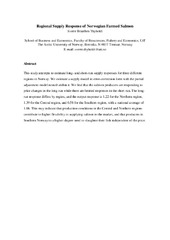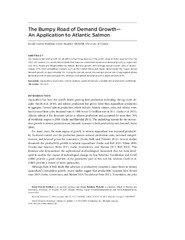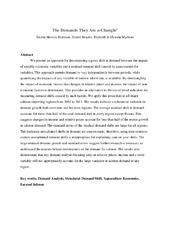| dc.contributor.advisor | Myrland, Øystein | |
| dc.contributor.author | Thyholdt, Sverre Braathen | |
| dc.date.accessioned | 2018-02-27T08:46:43Z | |
| dc.date.available | 2018-02-27T08:46:43Z | |
| dc.date.issued | 2015-06-17 | |
| dc.description.abstract | Price and quantity numbers, which we are observing in a market place, occur because of an
interaction between supply and demand. An understanding of what drives supply and demand
is therefore important in order to understand the market in itself. This dissertation focuses on
determining the impact of exogenous factors on salmon biomass growth and how producers
respond to price changes. Furthermore, we determine the total demand growth and the factors
affecting demand growth in the global salmon market.
The first paper determines the importance of temperature in the growth of Norwegian
farmed salmon for three different regions. The results show that sea temperature is a critical
factor to explain growth. Periods with higher sea temperatures lead to faster growth in the
North and Central regions, while leading to slower growth in the South.
In the second paper, salmon farmers’ response to price changes are estimated for three
different regions in Norway. We find that the salmon producers are responding to price
changes in the long run, while there are limited responses to price changes in the short run.
The long-run response differs from region to region, and the own-price supply elasticity is
1.22 for the Northern region, 1.39 for the Central region, and 0.58 for the Southern region,
with a national average of 1.06.
The third paper determines the magnitude of the shifts in annual demand across all
major salmon importing regions in the world. Results indicate that demand varies
considerably between years and regions and does not appear to follow a smooth trend, which
is usually assumed in empirical analysis.
The fourth paper extends the procedure of the third. We disentangle the impacts from
income growth and price changes in substitute products from total demand shift. The
remaining residual shift in demand is due to other unknown or omitted factors. Results
indicate that demand shifts due to unknown factors account for a large portion of total demand
growth in all regions, and this residual growth is not smooth in any region. The results
demonstrate that any demand analysis focusing only on relative prices, income, and a trend
variable will not appropriately account for the large variation in salmon demand in any region. | en_US |
| dc.description.doctoraltype | ph.d. | en_US |
| dc.description.popularabstract | Pris og mengde som observeres i et marked, inntreffer på grunn av en interaksjon mellom tilbud og etterspørsel. En forståelse av hva som er driverne bak tilbud og etterspørsel er derfor viktig for å kunne skjønne markedet i seg selv. Denne avhandlingen fastsetter hvordan eksogene, biofysiske faktorer påvirker tilveksten av laks. Resultatene viser at sjøtemperatur er en kritisk faktor og perioder med høyere sjøtemperaturer leder til raskere vekst i Nord- og Midt-Norge, mens det leder til saktere vekst i Sør-Norge. Norske lakseprodusenter responderer til prisendringer på lang sikt, med regionale forskjeller, mens på kort sikt er responsen begrenset. Videre analyseres den totale etterspørselsveksten for det globale laksemarkedet og hvilke faktorer som påvirker denne veksten. Etterspørselsveksten etter oppdrettslaks har i gjennomsnitt vært stor siden tidlig 2000-tall, men med en betydelig variasjon fra år til år og mellom de forskjellige lakseimporterende regioner i verden. | en_US |
| dc.description.sponsorship | UiT - The Arctic University of Norway | en_US |
| dc.description | The paper 1 of this thesis is not available in Munin. <br>
Paper 1: Thyholdt, S. B. (2014) The Importance of Temperature in Farmed Salmon Growth: Regional Growth Functions for Norwegian Farmed Salmon. Available in <a href=http://dx.doi.org/10.1080/13657305.2014.903310> Aquaculture Economics & Management 18(2):189–204. </a> Submitted manuscript available in Munin at <a href=http://hdl.handle.net/10037/7184> http://hdl.handle.net/10037/7184 </a> | en_US |
| dc.identifier.isbn | 978-82-8266-100-3 | |
| dc.identifier.uri | https://hdl.handle.net/10037/12216 | |
| dc.language.iso | eng | en_US |
| dc.publisher | UiT The Arctic University of Norway | en_US |
| dc.publisher | UiT Norges arktiske universitet | en_US |
| dc.rights.accessRights | openAccess | en_US |
| dc.rights.holder | Copyright 2015 The Author(s) | |
| dc.subject.courseID | DOKTOR-002 | en_US |
| dc.subject | Demand | en_US |
| dc.subject | Supply | en_US |
| dc.subject | Growth functions | en_US |
| dc.subject | Farmed salmon | en_US |
| dc.subject | VDP::Samfunnsvitenskap: 200::Økonomi: 210::Bedriftsøkonomi: 213 | en_US |
| dc.subject | VDP::Social science: 200::Economics: 210::Business: 213 | en_US |
| dc.subject | VDP::Landbruks- og Fiskerifag: 900::Fiskerifag: 920::Andre fiskerifag: 929 | en_US |
| dc.subject | VDP::Agriculture and fishery disciplines: 900::Fisheries science: 920::Other fisheries disciplines: 929 | en_US |
| dc.title | Just Like Putting Scissors to a Market -
Investigating Supply and Demand Relations of Farmed Atlantic Salmon | en_US |
| dc.type | Doctoral thesis | en_US |
| dc.type | Doktorgradsavhandling | en_US |


 English
English norsk
norsk


